|
White
|
1901
- 1980 |
Country: |
 |
|
Rollin H. White
The White steam cars were desacribed as 'Incomparable', but at first glance White steamers, products of the White Sewing Machine Company of Cleveland, looked little different from other steam buggies, Produced after 1900 as the brain child of Rollin H. White, they had full-elliptic suspension. and wooden reach-bars linking front and rear axles which were a normal feature of the design of such vehicles.
The White's semi-flash boiler made it unique in the New World. As developed by the company, the flash boiler consisted of a series of horizontal coils connected so that the water flowed down through them towards the burner, becoming progressively hotter until, by the time it reached the bottom tubes, directly over the heat, it had been flashed into superheated steam.
The White Flow Motor
To ensure a flow of water was directly proportional to the flow of fuel, the White was equipped with an ingenious automatic proportioning device called the 'flow motor': in fact, unlike most other steam cars, the control of the White power unit was virtually automatic, with lubrication taken care of by a distributor driven by a belt from the engine and a thermostat which closed down the fuel supply when the boiler tubes reached a temperature of around 150 degrees of superheat, or if the water supply ran out.
The little White Steam Carriage proved an instant success, and 193 were sold in 1901, the first complete year of production. Few changes were made for 1902, save for a six inch lengthening of the wheelbase to provide more leg room for the driver and passenger, and, subsequently, the adoption of a condensor which looked rather like a fire-guard, but in 1903 the little tiller-steered runabout grew up into a wheel-steered tonneau, with a double-acting compound engine housed at the front under a proper hood and an armored wood chassis with semi-elliptic springing.
The New-York-Buffalo Endurance Run
The manufacturers stated: 'The working parts being entirely encased, the White is impervious to mud and dust, while its operating parts are so arranged that a lady need have no fear of soiling even a glove in running the car ... there are no grinding cogs or terror-breeding explosions'. Right from the start, White had entered their products in competition: as early as September 1901 all four Whites had entered in the Automobile Club of America's New-York-Buffalo Endurance Run had secured class awards.
From an early date, White cars were imported into England by the enterprising Frederic Coleman, who, when the cars were banned from many speed events because of their ability, which was considered unfair, to generate maximum torque from a standstill, made sure that they retained public visibility by providing Whites as official transport. It was a car used by officials in the latter event which P. Armstrong, of Country Life, tried in the summer of 1904: 'The car travelled with a wonderful smoothness and silence, and with apparently a minimum of trouble to the driver.
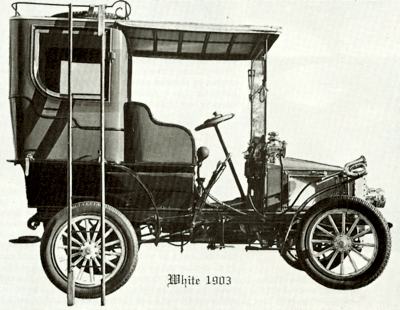 1903 White Steam Carriage, produced by the White Sewing Machine Company of Cleveland. It was powered by a semi-flash boiler.
1903 White Steam Carriage, produced by the White Sewing Machine Company of Cleveland. It was powered by a semi-flash boiler.
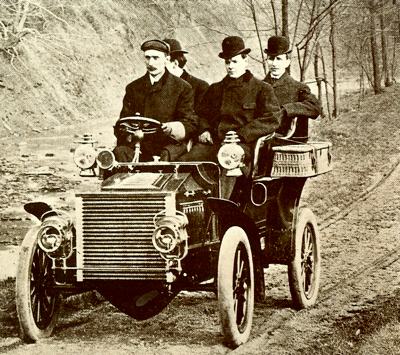 1903 White Steam Carriage.
1903 White Steam Carriage.
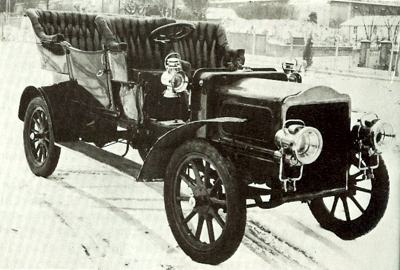 1905 White 15hp, which was capable of 50 mph despite its heavier construction. Its range between water fills was around 150 miles.
1905 White 15hp, which was capable of 50 mph despite its heavier construction. Its range between water fills was around 150 miles.
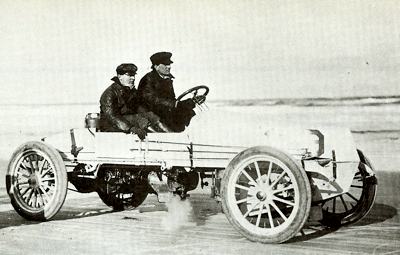 1905 White racer, known as 'Bob', being put through its paces by Rollin Whilte and Jay Webb.
1905 White racer, known as 'Bob', being put through its paces by Rollin Whilte and Jay Webb.
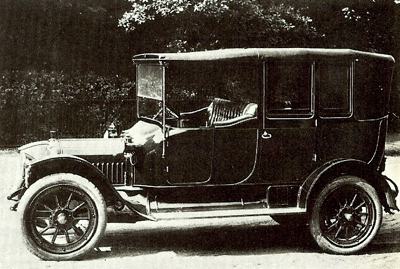 A petrol engined 1912 White 20hp tourer. A petrol engined 1912 White 20hp tourer.
|
We had not a single involuntary stop throughout the day, and beyond replenishing the petrol tank once and the water tank twice, the car received not a moment's attention from start to finish ... In regard to speed, the White can do thirty miles an hour with ease, which is ample for anyone who is not a victim of the speed mania. The possible average is anything up to twenty-four miles an hour. What struck me most forcibly about the car was the manner in which it took the hills. As a rule there was little perceptible slackening of speed on an ordinary incline, and even on the steepest gradients none of that sensation of effort which is so apparent on all but the most powerful of petrol cars.'
Coleman ensured the cars he sold would meet certain basic performance criteria: 'The vehicle is jacked up at the back and belts are run round the road wheels and on to a countershaft, from which is driven a dynamo. A switchboard, on which are a larger number of lamps is connected up to the dynamo, and a certain number of these have to be lit up to their full power before the car is passed as being up to standard.' Late in 1904 the 10 hp White was replaced by a more substantial 15 hp model, with a 50 hp speed potential despite its heavier construction, and a fan behind the condenser to increase the range between water fill-ups from 100 to 150 miles.
The Famous Whistling Billy
A two-speed back axle was standardised, which also incorporated a neutral 'free-engine' position so that the engine could now be run while the car was stationary, which eliminated the need to operate the feed pumps by hand before moving away from rest. In early racing a new White racer took to the track: this was the famous Whistling Billy, with an under-slung chassis and a massive condenser which formed the bonnet sides. In its first race, the car equalled the track record at the New York Morris Park circuit, covering a mile in 53 seconds. A week later, in Chicago, it netted its driver $2500 in three races. And on its return to Morris Park in July that year, Whistling Billy recorded a mile in 48.6 seconds.
Theodore Roosevelt
Publicity helped White sales: in 1906 they built 1500 cars, and numbered President Theodore Roosevelt among their customers. More powerful Whites were announced for 1907, the 20 hp Model L and the 30 hp Model K; these were replaced for 1909 by the 20 hp Model 0 and the 40 hp Model M. Improved design meant that the two-speed gearing and clutch mechanism were done away with, while the power unit, of a 'pleasing and symmetrical arrangement', was much simplified by the adoption of Joy valve gear instead of the Stephenson link motion of the early models.
Through the Alps to the Apennines
Unlike so many of its steam-powered contemporaries, the White was a practicable touring car: in 1911 P. G. Konody and four companions undertook a tour across France, over the Alps into Italy, through Austria and Germany and back via France, on a 30 hp White. Konody recorded his experiences in a now-rare, book, 'Through the Alps to the Apennines'. However, the market for steam cars was contracting rapidly, and in 1910 White introduced a Delahaye-inspired four-cylinder petrol car. Manufacture of steam cars ceased in 1911, though they were still listed in England, where they were assembled in a works at Camden Town, usually bodied by Cann & Company, until 1912.
The White 60hp Six
A 60 hp six-cylinder model was available in the US from 1912, but we believe this model was never exported; with twelve different models listed, White was now third biggest producer of luxury cars in America, though annual output was less than 2000. A new big four-cylinder model, with four valves per cylinder, appeared in 1917, but the following year the company gave up car production (save for the odd special order, until 1936) in favour of trucks. It was, a far-sighted decision, as, though the American luxury car business was to crumble, White's position in the heavy truck market became predominant, and their products eventually ensured the company's healthy survival into the 1970s.
Rollin White, however; who had once received a Gold Medal for conspicuous inventive skill at the St Louis World's Fair, still thought the quality car had a future, and in 1923 introduced the Rollin, a small, moderately-priced car built to high standards: but it lasted only two seasons before vanishing into limbo.
